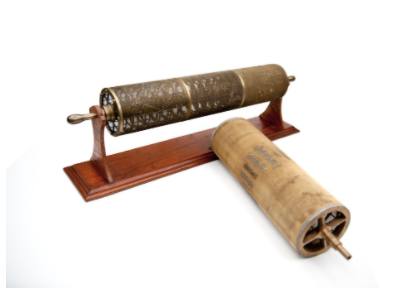Dandy Roll
September 1, 2020
This month’s artifact is a dandy roll. The dandy roll was invented in 1826 in England by a man named John Marshall, a maker of watermarks for handmade paper. After the invention of the Fourdrinier papermaking machine and the onset of industrial papermaking, he developed the dandy roll as a means of watermarking machine-made paper.
So, what is the difference between machine and traditional watermarking? In theory, not much. Both traditional watermark molds and the dandy roll involve thinning a pulled sheet of pulp in certain places in order to make a translucent design/mark on the surface of the paper. But instead of using a mold and deckle, the dandy roll is a hollow, metal cylinder that has a raised wire design attached to its surface. With industrial technology like the Fourdrinier papermaking machine, after a paper sheet has been formed it travels to the dandy roll which lightly rolls over it and presses a design into its wet fibers (at this point, the paper sheet will be approximately 97% water). Like a traditional watermark mold, as mentioned, the roll displaces and thins the paper fibers in the area where the design is pressed onto the sheet.
Our museum has a plethora of watermarking materials, dandy rolls among them. The first of our museum’s dandy rolls looks like a giant rolling pin and has “ABE GMS” embedded across its surface in wire. The other, accession number 941, has faces embedded onto its surface and is an example of how intricate and detailed watermarks and dandy roll designs can be.
Category: Tools
Region of Origin: European
Keywords:
Tools
